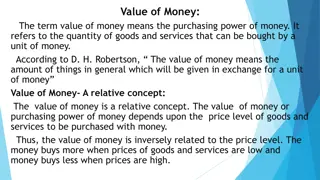Choosing Between Money-Weighted Return & Time-Weighted Return in CFA Level 1 Exam
Learn the differences and implications of Money-Weighted Return (MWRR) and Time-Weighted Return (TWRR) for your CFA Level 1 exam. Understand how to calculate these returns, their characteristics, and when each method is appropriate. Clear your calculator before computations, and remember the key tips for effective calculation. Know when to use MWRR or TWRR based on the control of cash flows.
Download Presentation

Please find below an Image/Link to download the presentation.
The content on the website is provided AS IS for your information and personal use only. It may not be sold, licensed, or shared on other websites without obtaining consent from the author.If you encounter any issues during the download, it is possible that the publisher has removed the file from their server.
You are allowed to download the files provided on this website for personal or commercial use, subject to the condition that they are used lawfully. All files are the property of their respective owners.
The content on the website is provided AS IS for your information and personal use only. It may not be sold, licensed, or shared on other websites without obtaining consent from the author.
E N D
Presentation Transcript
Choosing Between Money-Weighted Return & Time-Weighted Return In Your CFA Level 1 Exam source: http://soleadea.org/cfa-level-1/money-weighted-return-vs-time-weighted-return
CFA level 1 Quantitative Methods Exam Takeaway: MWRR vs TWRR
TIP 1 The money-weighted rate of return is an internal rate of return (IRR).
TIP 2 The time-weighted rate of return is a geometric mean return over the whole investment period.
TIP 3 You should remember to clear calculator worksheets before doing any computations.
TIP 4 To calculate the money-weighted return we use the CF and IRR worksheets (in your calculator remember to enter a minus sign in case of outflows).
TIP 5 When calculating the time-weighted return instead of calculating HPRs for consecutive periods it would have been faster if we computed 1 plus HPRs for these periods.
TIP 6 When calculating the time-weighted rate of return you don't need to know the number of shares that were bought/sold. You only need to know the prices of stock in different periods and the value of dividends.
TIP 7 Generally the money weighted and the time-weighted return are not equal. Exception: If throughout the investment period the investor does not sell any shares, nor does he purchase any new ones, and all received dividends are reinvested, then the money-weighted rate of return is equal to the time-weighted rate of return.
TIP 8 An investment manager has a full control of the timing of cash flows use money-weighted return for manager's evaluation; otherwise time-weighted return is preferable.
Blog post: http://soleadea.org/cfa-level-1/money-weighted-return-vs-time-weighted-return Download, print, and add your own notes for better knowledge retention: http://soleadea.org/sites/default/files/CFA-level-1-return-on-investment-print-pdf.pdf Create a free CFA study plan at: http://soleadea.org/study2/start























